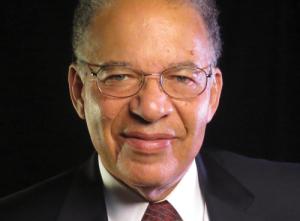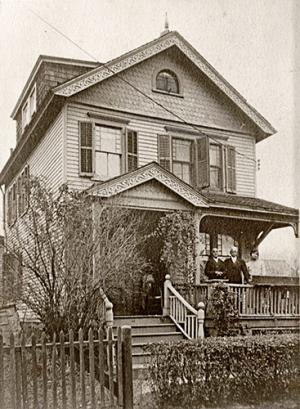Commemorating Black History Month
Hugh Price is formerly President of the National Urban League. His great grandmother was the sister of Lewis Latimer, one of the foremost founders of the electricity industry.
Ran Yan is Executive Director of the Lewis Latimer House Museum.
To celebrate this month of February, PUF hearkens back to a pioneer of our industry: Lewis Latimer. He was African American, the son of slaves, in fact. But he was also a key inventor of electric lighting, a Civil War veteran, and an impressive example of resilience in the face of systemic bias and even prejudice.

His legacy teaches many lessons about how we each can cultivate success regardless of our background. For this reason, PUF spoke with Hugh Price, Vice Chair of the board of the Lewis Latimer House Museum and former President and CEO of the National Urban League.
Lewis Latimer was Price's great-grand uncle, his sister Margaret Latimer Hawley his great-grandmother, and their parents George and Rebecca Latimer his great, great grandparents. With this ancestry in mind, he shared with us his thoughts on why Lewis Latimer's life and legacy matter today.
Hugh Price
Hugh Price: Lewis Latimer's life is of enormous importance historically and his legacy resonates powerfully in this day and age. His story is, in truth, many stories. Among them a compelling American as well as African American story, a diversity and equity story. The story of a man who was a key colleague of two of the creative geniuses of history, namely Alexander Graham Bell and Thomas Edison.
Latimer's is a story of what today we call STEM, and of the man who was one of and perhaps even the earliest apostles of adding the A, the arts, to become STEAM. He argued in a visionary paper presented to the Bridgeport Scientific Society in 1880, that art is integral to science.
 Hugh Price: The largest message and enduring legacy of Latimer’s life is he demonstrated 140 years ago why we have to cultivate, recruit, and utilize the talent that’s drawn from every segment of American society. He came as a teenager, the son of slaves, into the world that he occupied professionally.
Hugh Price: The largest message and enduring legacy of Latimer’s life is he demonstrated 140 years ago why we have to cultivate, recruit, and utilize the talent that’s drawn from every segment of American society. He came as a teenager, the son of slaves, into the world that he occupied professionally.
His story illustrates how mastery of the STEAM disciplines enabled the black man to gain access to and ascend within the American economic and business mainstream. Shattering glass ceilings along the way and becoming the first African American inducted as an Edison pioneer.
In addition to his notable inventions, Latimer pioneered as a black man who ran significant business operations for his employers in major cities in this country and internationally, namely Canada and Great Britain, and who became Edison's go-to expert on patent infringement.
Latimer's is a Horatio Alger story, of a talented and ambitious teenager from a hard scrabble background who was determined to excel and succeed in the mainstream business world. This is a story of a black man who ascended the ladder of responsibility in core business units, not just in diverse and inclusive market segments.
He was a trailblazer for the traditionally overlooked and excluded, namely minorities, women, and LGBT executives who many generations later follow in the path that he helped clear. This is a story of a business pioneer who demonstrated that people who are traditionally denied opportunity can compete and create, produce and perform as capably as anyone else.
 Latimer family on front porch, l-r, Mary Wilson Lewis (wife), Lewis Latimer, and Louise Latimer (daughter).
Latimer family on front porch, l-r, Mary Wilson Lewis (wife), Lewis Latimer, and Louise Latimer (daughter).
This is a story of a black man's indispensable contribution to the creation of everyday conveniences in lighting, electrification, and telecommunications among others, that we take for granted today. Latimer's is the story of a fabled inventor, an authentic Renaissance man, and an advocate for black people.
Let me conclude by citing The L Word: Generation Q, a series on Showtime. A major character in that series is played by Jennifer Beals. You may remember that she was the star of Flashdance and a co-star with Denzel Washington in Devil in a Blue Dress, which is one of my all-time favorite movies. In The L Word, Beals plays Bette Porter, who is the director of a high-profile art gallery in Los Angeles.
In one scene in season two episode two, her character tries to convince an artist who has honored Lewis Latimer in his work to sign with her gallery. Jennifer Beals says, I fell in love with your 2016 light installation. The artist replies, when I learned that a black man created the filament system, I knew I had to create something that was going to honor him.
Jennifer Beals replies, well, thanks to you, I think of Lewis Latimer every time I turn on a light switch. And as amazing and as inspiring as her comment is, let me call and raise Miss Beals by saying, I don't just think of Lewis Latimer, I thank Lewis Latimer every time I turn on a light switch.
 Ran Yan: We could use all the support from folks in the utilities industry. Any help in promoting Lewis Latimer’s story and his legacy would be greatly appreciated.
Ran Yan: We could use all the support from folks in the utilities industry. Any help in promoting Lewis Latimer’s story and his legacy would be greatly appreciated.
PUF's Steve Mitnick: He was a Renaissance man, with such a big role. But for our industry, for African Americans and perhaps all Americans, how are Latimer's life and accomplishments a model for us today?
Hugh Price: Well, I think the largest message and enduring legacy of Latimer's life is he demonstrated one hundred forty years ago why we have to cultivate, recruit, and utilize the talent that's drawn from every segment of American society. He came as a teenager, the son of slaves, into the world that he occupied professionally. Totally unexpectedly, unplanned. And look at what he accomplished and contributed.
That kind of talent and potential is out there in every segment of American society. He's a role model, exemplar, and trailblazer for African American businesspeople and executives, and people working in any segment of American society. For members of the gay and LBGT communities, Latino communities, you pick it. People who are traditionally excluded and overlooked, who aren't given opportunities to contribute such extraordinary talent and ability to mainstream society.
Think of what a loss it would've been if Latimer had not blossomed the way he did, and if Edison and Bell had not worked with him. And therefore, think about what a loss it would be for any organizations today, whether it's corporations, nonprofit organizations, government agencies, not to draw on the talent and potential of people from the segments of society that are traditionally overlooked. That's his basic legacy for me, that's the grandest legacy. Because he showed what is possible when you draw in, recruit, accept, and groom and promote people who have talent, regardless of however you might categorize them.
A second point I would make is that Latimer brings STEM to life. He shows what the impact is of mastering science, technology, engineering, and math. And the arts, as he advocated. How the mastery of those domains can equip people from the excluded of our society to become successful and productive in the social and economic mainstream.
That story resonates powerfully today as we look at the hiring patterns, recruitment patterns, promotion patterns in those industries. Whether it's utilities, telecommunications, or others, there's all this talent out there.
The story resonates powerfully about why it's important to examine the gaps in access to STEAM-related education that afflict communities of color across the United States. There have been studies in New York City and elsewhere that kids who are coming up in predominantly minority, predominantly low-income communities, don't get the exposure to STEAM-related content and courses early on.
If they don't get it early on, they can't get on the on-ramp to continue that coursework in junior high school, in high school, and then on into college and beyond. Latimer shows the power of that. Much of what he accomplished through STEAM was self-taught through determination, the hunger and curiosity to be successful.
There are many ways in which his lesson, his life, and legacy resonate. When you look at the fact that he was the son of slaves, his parents split up when he was very young, and his mother wasn't around to raise him. He lived in a school for boys that was run by the state. He escaped from that school for boys. He joined the Navy when he was underage, fifteen I think, and he fought in the Civil War. When he came out, he somehow figured out how to sell himself to Crosby and Gould, the law firm, that he knew something about drafting. And he taught himself.
I mean, that's just an amazing story, but it's an American story. So, there are a lot of levels. He speaks powerfully to the challenges we face today. As our society becomes increasingly diverse, organizations, corporations, entities are going to have to tap increasingly into the talent pool of the excluded and the overlooked. Latimer demonstrates the enormous potential that resides in that pool.
PUF: And even though he encountered bias throughout his life, it was amazing how he had a facility for dealing with and being respected by all sorts of people. Tell us about what that says for us.
Hugh Price: Well, there's a lot more about how he figured out how to do that, that we'd like to know. I haven't read nearly as much about that as I would like. It's one of the reasons why we are so eager to find a historian to write his biography, and ferret that out. But he had amazing navigational skills. He had a remarkable capacity to figure out the way something works, the way a place works. And he had a deep understanding of which way is up.
As we look at the entire history of black folks and the civil rights movement, it's both a battle for equal rights and a battle to ascend the ladder, knowing which way is up. Latimer knew that. He knew it instinctively and he practiced that in his career.
Obviously, there were setbacks and potholes in his life. When he worked for Maxim, at some point the company almost dissolved and Maxim left him. He was without a job. And he was back cutting hair and hanging wallpaper.
There was a resilience in him, which is also very instructive. Because, as we know, the private economy, the capitalist economy in this country is not a cakewalk. But he had an ability to understand how to get ahead.
He had an ability to perform and to get along harmoniously with his colleagues, and to understand what the rules of the road were. All of those are attributes critical to being successful in the mainstream society, which is a market-driven society. So that's why I think there're so many stories that can be unpacked from both what we know about his life and from understanding how he lived his life.
PUF: My last question is especially for young people. They could look at Latimer and say, this guy was an incredible genius. A young person may look to themselves and say I'm not a genius. But what could they take from Latimer, how do his lessons still apply?
Hugh Price: First I would say, who knew at age fifteen that he was a future genius? But that's one of the basic lessons, who knows what kind of talent is encased in a human being? Who knows how that talent will blossom if it can figure out how to work, have that talent and genius nurtured and cultivated?
I mean, I'm not a fan of rap music, but I remember coming home when my teenage daughter was listening to it in 1978. Our house was undulating on the foundations. And I said, what the hell is this music? And I thought, it won't last two years.
Yet look at the genius of Jay-Z and P Diddy, and all of those folks who understood and figured out, if you're going to sing, you ought to own your product. You ought to be vertically and horizontally integrated. Who knew when Jay-Z was twelve, that he would become who he became?
We don't know these things. We don't know how people will blossom and grow, and how they will learn and incorporate what they're exposed to, and who will be their mentors. One of the things about the way major institutions function, is they take talent development seriously, they are dedicated to spotting and cultivating talent.
When you read about the stories of the first wave of African Americans who became CEOs of major corporations in America, whether it's Ken Chenault of American Express, or Dick Parsons at Time Warner, they were all groomed and supported by their predecessors because they spotted the talent and potential. Well, our society has got to spot more talent and potential. It resides everywhere, and it needs to be cultivated wherever it is.
Young people have to recognize that they have talent and potential. The obligation of adults is to groom it and unleash it. The world abounds with examples. They can take heart in that. That's what I think Latimer's story speaks to. This is not to gainsay that there aren't obstacles out there, there aren't people who throw barriers in the way of kids. There are people who discount their value and their potential.
I vividly recall being in a meeting out in California where one of the most famous movie producers met one of the most significant private real estate developers in the United States. And they both discovered they were there because they had a keen interest in improving American schools.
What was fascinating is they discovered the reason that they were both so interested is that they had both been labeled as learning disabled when they were kids. They both said, I'll be damned if that's who I am.
They figured that since they had been labeled, then there must be millions of kids who are labeled that way. Mislabeled, misdiagnosed, "misunderestimated," to quote George Bush's famous phrase.
We have a tendency in our society to mislabel, misdiagnose, and misunderestimate young people. When there are educators who are determined to overcome that, school systems which are determined to overcome it, and parents, and kids who are determined to do it themselves, then there's all sorts of potential yet to be unleashed. Latimer's story is proof for how that worked even one hundred forty years ago.
Ran Yan
PUF's Steve Mitnick: You're the executive director of the Lewis Latimer House Museum. Why is there a museum and what makes the Latimer House so special?
Ran Yan: The house was the home for twenty-six years of the Latimer family. Lewis Latimer bought the house in 1902 and lived there till his death in 1928. It was the only house the Latimers owned in New York City and very possibly the only house they owned, period.
Historically speaking, the house is significant. The house is the physical evidence of Latimer's life, especially his later life in New York City. It witnessed many events, career progress, changes in his life, and the growth of his two daughters.
The house, architecturally speaking, is a two-and-a-half-story Victorian. That's typical from that time period. It is a modest home, and it provided a safe haven for the Latimer family for a long time. Latimer's granddaughter, Winifred Latimer Norman, worked hard to save the house and to establish it as a museum to celebrate her grandfather's legacy.
PUF: This was during a period of time when Lewis Latimer was working with Thomas Edison and George Westinghouse, other great inventors, and he became part of the Edison Pioneers. The house was frequented by some of the great names in African American history and was a regular meeting place.
Ran Yan: It was. Latimer was very much involved in the African American community in New York City. He was a close friend of W.E.B Du Bois, who visited the house frequently, among other Black jazz musicians and luminaries of the time.
PUF: With the museum there now, people visit, and schoolchildren are brought there to enjoy, learn, and be inspired. Do you oversee that?
Ran Yan: Yes. When the house was first turned into a museum, the original vision from Latimer's granddaughter, Winifred, was to focus on children's education, to educate the younger generations about Lewis Latimer and also about science, technology, and art.
Lewis Latimer was a Renaissance Man, he was a poet and a painter, in addition to being an inventor. We try to integrate the STEAM subjects in our educational programs - STEAM is science, technology, engineering, the arts, and math - in addition to teaching the history around Lewis Latimer.
We welcomed about forty to fifty school groups a year pre-pandemic. Now, because of the pandemic, in-person field trips are on hold, but we still do a lot of virtual programming for families and schools.
PUF: Coming up in less than two years is Lewis Latimer's one hundred and seventy-fifth birthday. At the Latimer House Museum, you have big plans for that birthday in September 2023. Talk about these plans and how they're evolving.
Ran Yan: Yes. We have an important initiative to plan for and produce a new permanent exhibition on the first floor of the house. The current exhibition at the house was done in 2005. It's been almost twenty years and it's long overdue for a redesign and upgrade.
We're actively working with an interpretive planner who's an expert in museum exhibitions to plan for a new permanent exhibition, which also is a big investment in the museum's future. This will be the foundation for our future educational, cultural, and public programs. Everything will stem from this new, permanent exhibition.
We are examining how we tell the history and what themes we focus on, because there's so much in Lewis Latimer's story, and one can go on and on about it. But we have limited space. So, there are many curatorial decisions to be made.
PUF: What's your fondest hope when this project is over, of how this will have more people thinking about Lewis Latimer's contributions to the development of our modern world with the telephone and electric lighting?
Ran Yan: We're hoping with a new exhibition once completed, that it will draw significantly more visitors from throughout New York City or the greater metropolitan area.
We're hoping to produce accompanying digital assets with a new exhibition to be distributed online and to conduct a strategic marketing campaign. The aim is to promote Lewis Latimer's legacy on multiple platforms, to reach all these folks such as your readers of the magazine, as well as members of the general public.
PUF: If our industry wants to help this project along, what can readers do to get this going and make sure there's a big celebration on September fourth, 2023?
Ran Yan: We could use all the support from folks in the utilities industry. Any help in promoting Lewis Latimer's story and his legacy would be greatly appreciated.
Any contribution to the museum toward the birthday celebration and also the new permanent exhibition would help us go a long way to complete the project.
PUF: Latimer's life was from 1848 to 1928. What is the meaning of his legacy for today, for our industry, for young people, that you're trying to accomplish through this museum?
Ran Yan: It's extremely important to have more inclusive perspectives in our history-telling, either in schools or in society in general, and for people to know what Lewis Latimer accomplished in the last century.
It's inspiring for him to have operated at the highest level of his industry back then. It was a high accomplishment, and sets a great example for people in the industry today to know they are represented in the history of when the industry first started.
Especially for the young people today to see there isn't a limit to what they can do in their careers and life. That is meaningful and is what we're trying to do by educating people about Lewis Latimer.
Lead image: Latimer House Today – photo by Adrian Sas.



